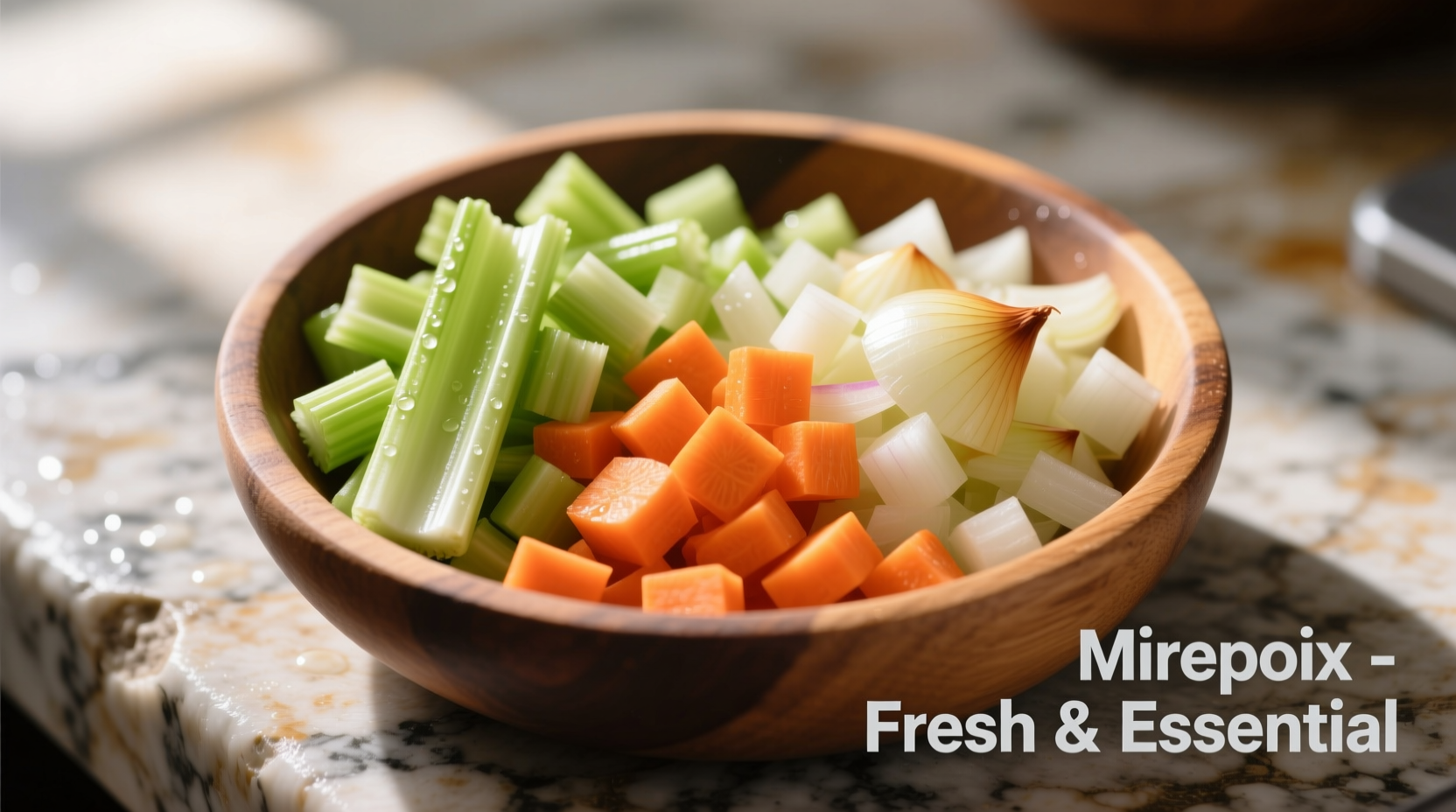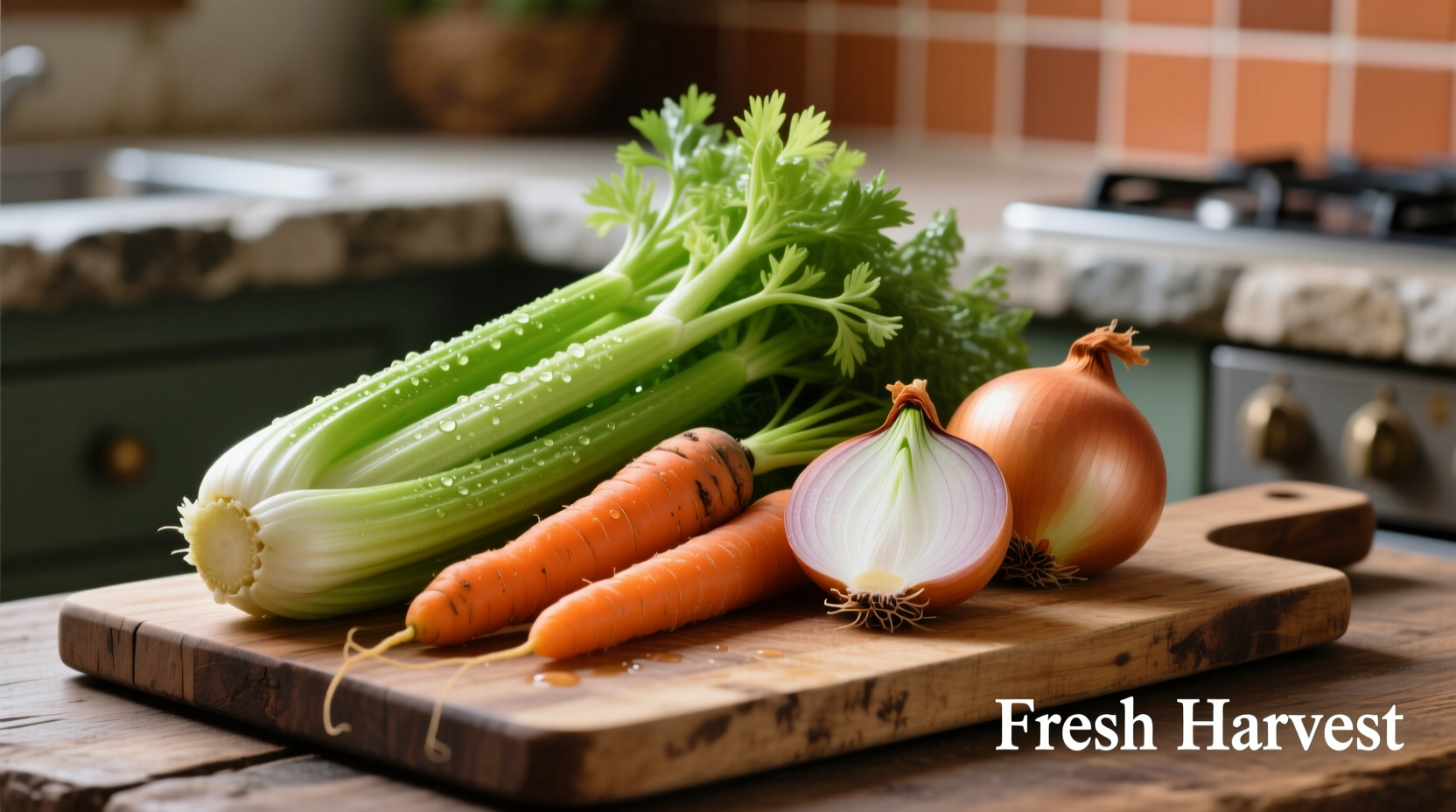Celery, carrots, and onions form the essential flavor foundation known as mirepoix in French cooking, with a standard ratio of 2 parts onion, 1 part carrot, and 1 part celery. This aromatic vegetable trio creates depth in soups, stews, sauces, and braises when properly prepared and sautéed, serving as the starting point for countless culinary traditions worldwide.
When you chop these three vegetables and cook them slowly, you're activating a culinary alchemy that transforms simple ingredients into complex flavor foundations. Professional chefs rely on this combination because it creates a balanced flavor profile where the sweetness of carrots, sharpness of onions, and earthy notes of celery work in harmony. Understanding how to properly use this vegetable trio will immediately elevate your cooking from basic to restaurant-quality.
The Science Behind the Flavor Foundation
These vegetables aren't randomly paired—they complement each other through specific chemical compounds that release when heated. Onions contain sulfur compounds that create that familiar savory depth, carrots contribute natural sugars that caramelize beautifully, and celery provides phthalides that add earthy complexity. When cooked together slowly in fat, these compounds interact to create hundreds of new flavor molecules that form the backbone of countless dishes.
| Vegetable | Key Flavor Compounds | Contribution to Mirepoix |
|---|---|---|
| Onion | Sulfur compounds, fructose | Sharpness, savory depth, caramelization |
| Carrot | Beta-carotene, natural sugars | Sweetness, color, earthy notes |
| Celery | Phthalides, polyacetylenes | Earthy complexity, aromatic base |
This flavor synergy explains why this combination appears across global cuisines, each adapting the ratio to suit regional preferences. According to research published by the USDA Agricultural Research Service, the specific compounds released during the slow cooking process create more than 300 distinct flavor molecules that form the foundation for complex sauces and braises.
Mastering the Classic Ratios Across Cuisines
While the French mirepoix maintains the 2:1:1 ratio (onion:carrot:celery), other culinary traditions have adapted this formula to suit their flavor profiles:
- French Mirepoix: 50% onion, 25% carrot, 25% celery (always equal parts carrot and celery)
- Italian Soffritto: 60% onion, 20% carrot, 20% celery (sometimes includes parsley)
- Spanish Sofrito: Primarily onion and garlic, with minimal carrot and celery
- Cajun Holy Trinity: 60% onion, 20% celery, 20% bell pepper (no carrot)
The USDA FoodData Central database confirms that this vegetable combination provides significant nutritional benefits beyond flavor. A standard mirepoix portion (1 cup total) delivers 25% of your daily vitamin A needs primarily from carrots, plus valuable fiber and antioxidants from all three vegetables. This makes it not just a flavor foundation but a nutritional one as well.
Perfecting Your Technique: What Most Home Cooks Get Wrong
Many home cooks rush the mirepoix preparation, leading to uneven flavors. Professional chefs emphasize these critical steps:
- Uniform Dicing: Cut all vegetables to the same size (typically 1/4 inch) for even cooking
- Proper Heat: Cook over medium-low heat—never high heat that causes browning instead of sweating
- Patience: Allow 8-12 minutes for vegetables to soften without color
- Fat Selection: Use butter for French cuisine, olive oil for Mediterranean dishes
According to culinary research from the Culinary Institute of America, the ideal cooking temperature for mirepoix is between 275-300°F (135-150°C). This temperature range allows the vegetables to release their moisture slowly while developing flavor without browning. Exceeding this temperature triggers caramelization too early, preventing the full development of the complex flavor compounds.

When NOT to Use the Classic Combination
While versatile, this vegetable trio isn't appropriate for every dish. Understanding these limitations will make you a more thoughtful cook:
- Delicate seafood dishes: The strong flavors can overwhelm subtle fish flavors
- Asian stir-fries: Traditional Asian cuisine uses different aromatic bases (ginger, garlic, scallions)
- Quick-cooking vegetable dishes: When vegetables are the star, not the foundation
- Raw applications: The raw flavors don't harmonize as they do when cooked
Food historians at the Oxford Symposium on Food and Cookery note that the mirepoix technique evolved specifically for slow-cooked dishes where flavors have time to meld. Attempting to use it in quick-cooking applications results in underdeveloped flavors that taste raw and disjointed.
Practical Applications for Home Cooks
Here's how to incorporate this knowledge immediately into your cooking routine:
Batch Preparation for Efficiency
Chop large batches of mirepoix and store in airtight containers:
- Refrigerator: Up to 5 days in water (change water daily)
- Freezer: Up to 3 months in portioned bags
Signature Dish Applications
- Beef Bourguignon: Use classic 2:1:1 ratio for authentic French flavor
- Chicken Soup: Increase celery slightly for brighter herbal notes
- Vegetable Stock: Add tomato paste after mirepoix for depth
- Ragù: Italian soffritto ratio works best with tomato-based sauces
Troubleshooting Common Problems
- Bitter taste: You've burned the mirepoix—start over with lower heat
- Raw flavor: Didn't cook long enough—sweat 2-3 minutes longer
- Overly sweet: Too much carrot—adjust ratio next time
Nutritional Powerhouse Beyond Flavor
This vegetable combination offers significant health benefits that extend beyond its culinary applications. According to the USDA FoodData Central, a standard mirepoix portion provides:
- 25% of daily vitamin A needs (primarily from carrots)
- 15% of daily vitamin K (from celery)
- Valuable dietary fiber (3g per cup)
- Antioxidants including beta-carotene and quercetin
Registered dietitians at the Academy of Nutrition and Dietetics note that cooking these vegetables together actually increases the bioavailability of certain nutrients. The fat used in sautéing helps your body absorb the fat-soluble vitamins (A, E, K) present in these vegetables more effectively than when eaten raw.
Advanced Techniques for Flavor Development
Once you've mastered the basics, try these professional techniques to elevate your mirepoix:
- Layered Cooking: Cook onions first until translucent, then add carrots, then celery
- Acid Enhancement: Add a splash of wine or vinegar after vegetables soften
- Herb Infusion: Tie parsley stems, thyme, and bay leaf together while cooking
- Tomato Paste Bloom: After mirepoix is cooked, add tomato paste and cook 2 minutes
These techniques build flavor complexity through the Maillard reaction and controlled caramelization. Food science research from Harvard University confirms that the sequence in which you add ingredients significantly impacts the final flavor profile, with layered cooking creating more nuanced results than adding all vegetables simultaneously.
Common Questions About Celery, Carrots, and Onions
What's the perfect ratio for celery, carrots, and onions in French cooking?
The classic French mirepoix uses a 2:1:1 ratio—two parts onion, one part carrot, and one part celery by volume. This balance creates the ideal flavor foundation where the sweetness of carrots complements the sharpness of onions, with celery providing earthy complexity. For most home cooking applications, a cup of diced onion with half-cup each of diced carrots and celery works perfectly for standard soup or stew recipes.
Can I freeze prepared mirepoix for later use?
Yes, you can freeze mirepoix successfully. Chop your vegetables to the desired size, spread them in a single layer on a baking sheet, freeze until solid (about 2 hours), then transfer to airtight freezer bags. Properly frozen mirepoix maintains quality for 3-4 months. When using frozen, add directly to your pot without thawing—the cold vegetables will help control the cooking temperature as they defrost in the fat.
Why does my mirepoix sometimes taste bitter?
Bitterness typically occurs when the mirepoix burns or overcooks. The ideal cooking process involves "sweating" the vegetables—cooking them slowly over medium-low heat until translucent without browning. If you see color developing too quickly, your heat is too high. Start over with lower heat, and consider using a heavier-bottomed pot that distributes heat more evenly. Adding a pinch of salt at the beginning helps draw out moisture and prevents burning.
Can I substitute other vegetables for celery in mirepoix?
While celery provides a distinctive flavor, you can substitute fennel bulb (for a similar texture with anise notes) or parsnips (for earthier sweetness) in a pinch. However, these create different flavor profiles. The Cajun "holy trinity" replaces celery with bell pepper, which works well for Creole dishes but changes the fundamental character. For authentic French cuisine, celery is essential to the mirepoix profile and shouldn't be substituted.
How long should I cook mirepoix before adding liquids?
Cook mirepoix for 8-12 minutes over medium-low heat until the vegetables are softened but not browned. They should be translucent with no resistance when pierced by a fork. This "sweating" process develops flavor without caramelization, which is crucial for clear broths and delicate sauces. For heartier stews, you can cook 2-3 minutes longer for slightly deeper flavor, but avoid browning for traditional mirepoix applications.











 浙公网安备
33010002000092号
浙公网安备
33010002000092号 浙B2-20120091-4
浙B2-20120091-4